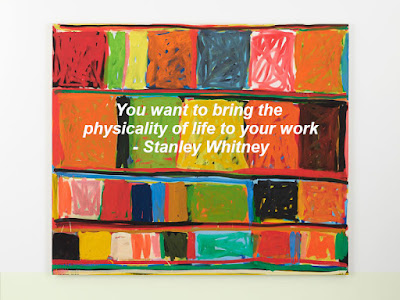(photo: ©Stanley Whitney)
"You want to bring the physicality of life to your work"
-Stanley Whitney
I've always embraced various types of textures in my painting, but never anything that was too obvious, at least from a distance. Mostly, it's been visual texture through the manipulation of forms on the surface. These textures don't rise from the painting's surface, but are just changes in how the paint or drawing material is handled. I had a period in the late '90s where I made a bunch of mixed media works where plexiglas, aluminum and wood were used in a variety of ways and had their own textures. I've never embraced really thick applications of paint on my paintings to create texture-it always seemed to be too much about surface, whereas I've been more interested in making spatial environments that rely on changes in scale to create depth. I went for textures that were a little more subtle. Like the mildly sandpapery Micaceous Iron Oxide (MIO) that Golden makes. Once dry, MIO has a surface that may be equivalent to 100 grit sandpaper Not too chunky, but still noticeable to the eye, and it's somewhat reflective.
Lately, I've wanted to make some of my glyphs stand out from the surface. I've found that a heavy gel medium does the trick very well. Not only does it create a good peak, it gives a nice, almost encaustic-like look to the paint. Now, I want to experiment with adding differing amounts of paint and dried pigments to the gel medium to see how it acts.
"The physicality of life" is such a perfect way to describe what I want to bring to my work. That can take the form(s) of brushstrokes, scraping of paint, drips, covering of areas and so on. It's not only the look, but the general feeling that I hope to communicate. I like that some of my paintings feel like they're still in the process of evolving, even when I've chosen to stop working on them. Allowing some of the making process to be seen keeps the work alive in a way that I can't explain. It's similar to when observing the changes in my environment, on my walks, subtle and not so subtle; there's almost always a feeling of small wonderment at recognizing shifts in the world around me. Doing this reminds me of how life is in continual change and flux, something that I want to convey to the viewer. My hope is that through the work, they'll recognize and appreciate something of what I see and experience.
TM

No comments:
Post a Comment